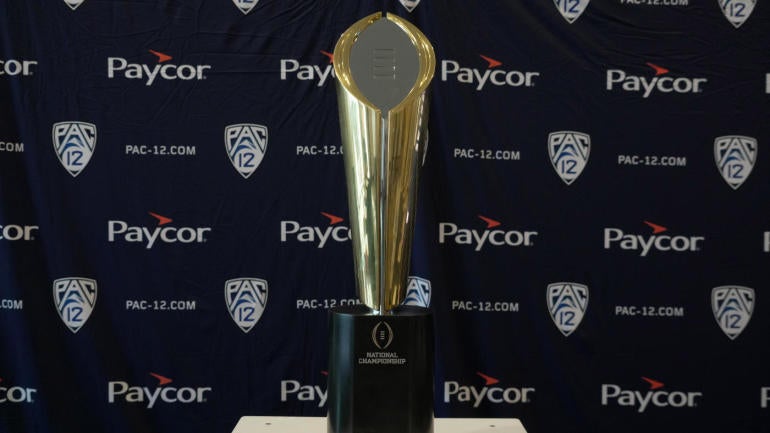
With Oregon and Washington leaving the Pac-12 for the Big Ten following the 2023 season, the balance of power in college sports is swinging so hard in the direction of the Big Ten and SEC that it raises a critical question about college football's postseason. How long will those two leagues remain content with the previously agreed upon structure for the 12-team College Football Playoff?
The 12-team CFP, which begins with the 2024 season, previously decided to grant automatic bids to the top six conference champions in the CFP rankings, with the remaining bids going to the top six teams who didn't win their conference title. But that system was agreed to by the CFP Board of Managers when it seemed like the Pac-12 would survive as a "power conference" propped up by football brands Oregon, Washington and Utah.
Now, amid the Big Ten's four West coast additions and the defections of Arizona, Arizona State, Colorado and Utah for the Big 12, the Pac-12 could soon be a league propped up by Oregon State, Washington State, Cal and Stanford, if it continues to exist at all. Yet, it could still be well-positioned to produce a CFP team under the agreed upon 12-team structure. Unless, of course, the powerful leagues push for a change to the format in light of the Pac-12's demise.
Could AQ bids be on the way out?
SEC commissioner Greg Sankey already made it seem like an act of charity to concede any automatic bids amid the long saga of CFP expansion. He certainly can't be thrilled by the agreement now. After all, the SEC, which only plays an eight-game conference schedule, would benefit greatly if all CFP bids were granted on an at-large basis.
The awarding of automatic bids to the top six league champions was viewed as a way to achieve national CFP representation and to ensure the little guy would have a shot on college football's big stage with at least one berth going to a Group of Five conference champion. The boards and committees guiding the CFP are well-represented with administrators from Group of Five schools, and that sixth automatic bid was a nod to them.
Cincinnati stood on the shoulders of UCF's success and its own back-to-back undefeated regular seasons to somewhat miraculously make the four-team CFP in 2021. Under the new 12-team format, a Group of Five school would no longer have to move heaven and earth while seeing the stars align in order to have a chance at competing for a national title. The sixth automatic bid also signaled at least some reassurance that the future of Division I college sports belonged to more than just the Power Five or Big Two.
Now, under the agreed upon CFP structure, there will be not ONE but TWO non-major conferences (assuming a whittled-down Pac-12 will no longer be considered a major conference) getting a shot from a group of "have-nots" headlined by the following: Oregon State, Washington State, Cal, Stanford, Tulane, UTSA, Boise State, Troy, Air Force, SMU, South Alabama, Coastal Carolina, Memphis, Fresno State, Marshall and Appalachian State.
The list of Group of Five/leftover Pac-12 schools goes on, but you get the picture.
The Power Five could shrink to the 'Power Four'
A 12-team College Football Playoff featuring two conference champions from that group would be different than what the Board of Managers likely envisioned. But it would double the Cinderella possibilities and push the event further into the mold of what makes the NCAA Tournament so wonderful in basketball. A playoff featuring two conference champions from outside the sport's ruling class would also regularly bring national stakes to games played on the blue turf of Boise State and on the "surf turf" of Coastal Carolina.
It would ratchet up the pressure from the power conference teams to perform in the regular season, too. That should appeal to traditionalists who never wanted CFP expansion in the first place.
You can already hear it, though, can't you? The backchannel whispers emanating from the privileged class. *We were already being nice to our impoverished underlings by offering them one spot in the playoff. Now we're giving them two? Let's get this back to the drawing board before a 12-1 Coastal Carolina makes the CFP over a 9-3 LSU just because they won the stupid Sun Belt.*
SEC, Big Ten could get more
If you believe for a second that the Big Ten and SEC will be content to see one-sixth or 16.7% of the playoff spots taken up by the have-nots, then you haven't been paying attention to college sports for the past 15 years.
The CFP's long-term media rights situation is up in the air past the 2025-26 season. Given how significant the influence of media rights holders has become in college sports, expect a significant push in the months ahead to tweak the CFP formula in a way that benefits the Big Two as the CFP enters a new media agreement. A three-loss Michigan team is almost certainly of more interest to a network than an 11-1 Fresno State team.
Schools that will be part of the Big Ten and SEC come 2024 comprise 11 of the top 14 ranked teams in the CBS Sports 133 entering this season. The best collection of college football in the country will compete in those two conferences. Of that, there is no doubt.
However, the new members of those conferences chose to chase paychecks instead of the playoff. If making the CFP were a primary objective for Oregon and Washington, they would have stayed in the Pac-12 and thrown their weight around in a league that is losing high-level competitors UCLA and USC. The same goes for Oklahoma and Texas, whose paths to the CFP will be paved with SEC roadblocks.
Maybe, deep down, there are some good intentions behind these moves. Perhaps university administrators are concerned that, eventually, the courts will make student-athletes employees. At that point, the schools will need to be well-fortified financially to avoid putting olympic and non-revenue sports on the chopping block.
Paying competitive salaries to hundreds of athletes across an entire athletic department won't be cheap, and preserving opportunities and access for those beyond the primary money-makers is a noble ideal. It increases the appeal of college sports to a wider swath of the population and is good for the long-term health of sports in this nation.
But if that's really an ideal behind this wave of realignment, then prove it. Keep that same spirit and give an accessible 12-team College Football Playoff the chance to work -- even if that means letting two of the peasants sit at the table of elites.
















